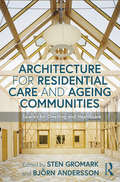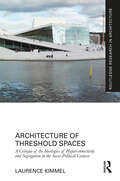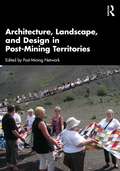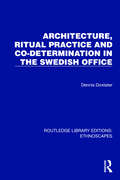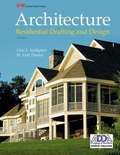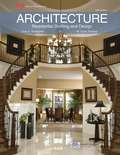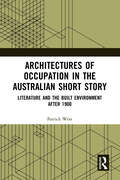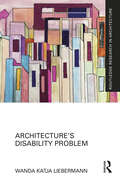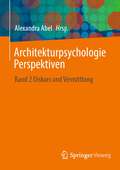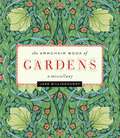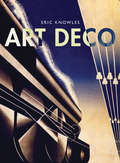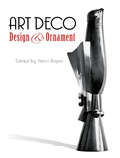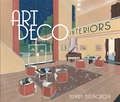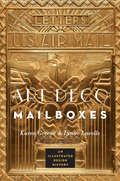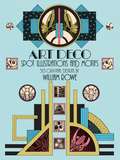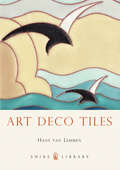- Table View
- List View
Architecture for Residential Care and Ageing Communities: Spaces for Dwelling and Healthcare
by Sten Gromark; Björn AnderssonArchitecture for Residential Care and Ageing Communities confronts urgent architectural design challenges within residential innovation, ageing communities and healthcare environments. The increasing and diversified demands on the housing market today call for alterability and adaptability in long term solutions for new integrated ways of residing. Meanwhile, an accentuated ageing society requires new residential ways of living, combining dignity, independence and appropriate care. Concurrently, profound changes in technical conditions for home healthcare require rethinking healing environments. This edited collection explores the dynamics between these integrated architectural and caring developments and intends to envision reconfigured environmental design patterns that can significantly enhance new forms of welfare and ultimately, an improved quality of life. This book identifies, presents, and articulates new qualities in designs, in caring processes, and healing atmospheres, thereby providing operational knowledge developed in close collaboration with academics, actors and stakeholders in architecture, design, and healthcare. This is an ideal read for those interested in health promotive situations of dwelling, ageing and caring.
Architecture in Motion: The history and development of portable building
by Robert KronenburgThe idea that architecture can be portable is one that grabs the imagination of both designers and the people who use it, perhaps because it so often forecasts a dynamic and creative solution to the complex problems of our contemporary mobile society, while at the same time dealing with issues of practicality, economy and sustainability. Architecture in Motion examines the development of portable, transportable, demountable and temporary architecture from prehistory to the present day. From familiar vernacular models such as the tent, mobile home and houseboat, to ambitious developments in military and construction engineering, all aspects of portable building are considered. Building on his earlier works Portable Architecture and Houses in Motion, Robert Kronenburg compares traditional forms of building, current commercial products and the work of innovative designers, and examines key contemporary portable buildings to reveal surprising, exciting and imaginative examples. He explores the philosophical and technological issues raised by these experimental and futuristic prototypes. By understanding the nature of transitory architecture, a new ecologically aware design strategy can be developed to prioritise buildings that 'tread lightly on the earth' and still convey the sense of identity and community necessary for an established responsible society. This book provides a unique insight into this pivotal field of design.
Architecture of Threshold Spaces: A Critique of the Ideologies of Hyperconnectivity and Segregation in the Socio-Political Context (Routledge Research in Architecture)
by Laurence KimmelThis book explores the relationship between architecture and philosophy through a discussion on threshold spaces linking public space with publicly accessible buildings. It explores the connection between exterior and interior and how this creates and affects interactions between people and the social dynamics of the city. Building on an existing body of literature, the book engages with critical philosophy and discusses how it can be applied to architecture. In a similar vein to Walter Benjamin’s descriptions of the Parisian Arcades in the nineteenth century, the book identifies the conditions under which thresholds reveal and impact social life. It utilises a wide range of illustrated international case studies from architects in Japan, Norway, Finland, France, Portugal, Italy, the USA, Australia, Mexico, and Brazil. Within the examples, thresholds become enhancers of social interactions and highlight broader socio-political contexts in public and private space. Architecture of Threshold Spaces is an enlightening contribution to knowledge on contemporary architecture, politics and philosophy for students, academics, and architects.
Architecture, Landscape, and Design in Post-Mining Territories
by Post-Mining NetworkThis edited collection explores how architects, planners, and landscape architects can engage with former mining sites and communities.Chapters investigate how to move from an extractivist system towards a territorialist project, working towards the reappropriation of territorial resources after centuries of subordination of local and immigrant populations. The first part reviews cases from European sites, including examples from France, Germany, and Romania that highlight intangible heritage as the subject of a territorial project. A special focus is placed on the coalfields of northern France, a UNESCO World Heritage site since 2012, where many experimental projects are being carried out. The second part explores the great American landscapes transformed by the extractive industry in the United States, Brazil, and Chile. Fully illustrated throughout, this book features photos showcasing architectural and landscape achievements, as well as drawings of future projects. Contributors respond to the design challenges of post-mining landscapes, foreshadowing new and varied transformative horizons. The cases present a rich and articulate collection of ‘on-the-ground’ projects.This book is essential for practitioners and students of architecture and urban planning, as well as associations and political and technical actors in post-mining communities.
Architecture, Ritual Practice and Co-determination in the Swedish Office (Routledge Library Editions: Ethnoscapes)
by Dennis DoxtaterOriginally published in 1994, as part of the Ethnoscapes: Current Challenges in the Environmental Social Sciences series, reissued now with a new series introduction, Architecture, Ritual Practice and Co-determination in the Swedish Office is a case study of Swedish office buildings and examines how they have been influenced by spatial aspects of traditional culture in Scandinavia. It suggests a theoretical framework for architecture by casting the ritual form of Swedish offices into three distinct modes of expression.
Architecture: Residential Drafting and Design
by Clois E. Kicklighter Joan C. KicklighterArchitecture: residential drafting and design provides the basic information necessary for planning various types of dwellings. The book is so organized that the content is presented in the logical order of use and is highly illustrated with the very latest products and building techniques.
Architecture: Residential Drafting and Design
by Clois E. Kicklighter Joan C. Kicklighter W. Scott ThomasArchitecture: Residential Drafting and Design provides comprehensive instruction for preparing architectural working drawings using traditional and computer-based methods. The text also serves as a reference for design and construction principles and methods. Its highly effective formatorganizes content around the design-building process, making the text easy to understand and appealing to students. The new edition of this text has been extensively revised and features new chapters covering sustainable design and building sections. New chapter features include Green Architecture, Employability, Problem Solving Case Study, and Curricular Connections to expand on chapter topics, explain currenttrends, and promote student interest. Each chapter contains sample test questions for the American Design Drafting Association (ADDA) Drafter Certification Test to help students work toward earning professional certification. The text has been enhanced with a new, colorful design and includes manynew detailed illustrations to explain topics. Each chapter includes objectives, key terms, Internet resources, review questions, and suggested activities for individuals or small groups. Many of the chapterend activities are designed to give students experience working with computer-aided draftingand design (CADD) systems.
Architecture: Residential Drafting and Design (Twelfth Edition)
by Clois E. Kicklighter W. Scott ThomasArchitecture: Residential Drafting and Design provides comprehensive instruction on traditional and computer-based methods of preparing architectural working drawings, as well as coverage of design and construction principles and methods. It is organized around the design-building process, a logical way for students to easily learn. It is intended to help build the necessary technical skills to communicate architectural ideas in an understandable, efficient, and accurate manner. Architecture: Residential Drafting and Design covers all phases of architectural drafting and design. In addition to providing information on architectural drafting, design, and construction, the text includes excellent coverage of computer-aided drafting and design (CADD), 3D parametric modeling applications, and building information modeling (BIM).
Architecture: Residential Drafting and Design (Twelfth Edition)
by Clois E. Kicklighter Joan C. Kicklighter W. Scott ThomasNIMAC-sourced textbook
Architectures of Occupation in the Australian Short Story: Literature and the Built Environment after 1900
by Patrick WestPatrick West’s Architectures of Occupation in the Australian Short Story cultivates the potential for literary representations of architectural space to contribute to the development of a contemporary politics of Australian post-colonialism.West argues that the predominance of tropes of place within cultural and critical expressions of Australian post-colonialism should be re-balanced through attention to spatial strategies of anti-colonial power. To elaborate the raw material of such strategies, West develops interdisciplinary close readings of keynote stories within three female-authored, pan-twentieth century, Australian short-story collections: Bush Studies by Barbara Baynton (1902); Kiss on the Lips and Other Stories by Katharine Susannah Prichard (1932); and White Turtle: A Collection of Short Stories by Merlinda Bobis (1999). The capacity of the short-story form to prompt creative and politically germinal engagements with species of space associated with architecture and buildings is underscored. Relatedly, West argues that the recent resurgence of binary thought—on local, national, and international scales—occasions an approach to the short-story collections shaped by binary relationships like a dichotomy of inside and outside. Concluding his argument, West connects the literary and architectural critiques of the story collections to the wicked problem, linked to ongoing colonial violences, of improving Australian Indigenous housing outcomes.Innovative and interdisciplinary, this book will be of interest to scholars and students of Literary, Architectural, and Postcolonial Studies. .
Architecture’s Disability Problem (Routledge Research in Architecture)
by Wanda Katja LiebermannArchitecture’s Disability Problem explores the intersection of architecture and disability in the United States from the perspective of professional practice. This book uncovers why, despite the profound effect of the Americans with Disabilities Act on the architectural profession, there has been so little interest in design for disability in mainstream architecture. To counter this, the book investigates alternative approaches to designing with disability, through three case studies. These showcase both buildings and how design processes driven by disabled people shape design and professional roles.Combining historical research, formal and discourse analysis, and interviews with people who design, construct, use buildings, and advocate for access, the book develops a social understanding of how the buildings work at functional, affective, and symbolic levels. Architecture’s Disability Problem is aimed at three primary readers: practicing architects, architectural scholars, and members of disability scholar-activist communities. Grounded in detailed design studies, the author hopes to unearth the social meaning-making of architecture related to disability. Ultimately, the book makes an argument for a focus on disability in its own right—as well as on the body—in place of the dominance of formal, object-oriented approaches.This book presents and argues for a fundamental shift in the way architectural education, policy, and practice views and engages with disability. It will be key reading for students, researchers, practitioners and policy-makers.
Architekturpsychologie Perspektiven: Band 2 Diskurs und Vermittlung
by Alexandra AbelIn der gebauten und vom Menschen beeinflussten Umwelt manifestiert sich unser Leben: Lebenshaltung, Lebensformen, Lebensentwurf. Indem man Architektur neu denkt, hat man daher das Potential, die derzeitige Form unseres Lebens zu überdenken. Ein solches Neu, Anders braucht eine Sensibilisierung für die Relevanz der gebauten Umwelt, für die Werte und Zielgrößen, die hinter einer bestimmten Gestaltung stehen und braucht einen gesamtgesellschaftlichen Diskurs zu der zentralen Frage: Wie wollen wir leben? Wie dürfen wir leben? Vor dem Hintergrund ökologischer und ökonomischer Fairness: Welche Lebensformen sind kompatibel mit einer möglichst hohen Lebensqualität für uns alle, als Teil eines Ökosystems, mit dem unser Wohlbefinden unauflöslich verbunden ist. In diesem Band kommen namhafte Expertinnen aus Österreich, der Schweiz und Deutschland aus den Disziplinen der Architektur, der Psychologie, der Kunst und Kunstdidaktik zu Wort, die sich zu der Relevanz und zu den Voraussetzungen einer solchen Debatte äußern.
Architekturpsychologie Perspektiven: Band 3 Entwurf und Prozess
by Martina GuhlWie findet die Begegnung von Psychologie und Architektur während des Entwurfs- und Planungsprozesses statt? In welchem Planungsabschnitt wird architekturpsychologisches Wissen relevant und einsetzbar? Welche Erkenntnisse liefert die urbane Architekturpsychologie für den städtebaulichen Diskurs? In diesem Buch bringen renommierte Expert*innen aus Deutschland, der Niederlande und der Schweiz aus den Disziplinen Architektur, Psychologie, Städtebau, Farbgestaltung und Kommunikationspsychologie ihr Pionierwissen ein.
Are You Ready?
by Maggie MooneyAs earthquakes have struck around the world with alarming frequency, millions have realized they are unprepared for similar catastrophes close to home. Online disaster plans and older books-heavy with seismic science and a survivalist focus-leave the average reader overwhelmed with details and anxiety. How much water will I need? What if I'm driving? How do I protect my six-year-old? The questions go on-and in this book Maggie Mooney answers them. Her four-week readiness program includes straightforward instructions, forms, and checklists. Mooney explains what to expect during a quake, and what to do when the shaking stops. She also addresses both aftershocks and tsunamis.Use this guide and the checklists inside to get ready:Find your safe spots at home, at work, at school, and outdoors.Develop your emergency communication plan.Shake-proof your home.Assemble emergency supplies. By following the steps in the four-week readiness program described here you can avoid injury and ensure you have the food, water and other essentials you need to be prepared rather than scared.
Armchair Book of Gardens: A Miscellany
by Jane BillinghurstThe Armchair Book of Gardens is a collection of indiviual essays focused on understanding gardens in a different light/perspective. The book concentrates on the emotional, social, spiritual, and politicial aspects of the garden.
Armitage's Vines and Climbers: A Gardener's Guide to the Best Vertical Plants
by Allan M. Armitage“Climbing plants are hugely underrated—this book with its lively expression of deep knowledge should encourage everyone to grow more of them.” —Noël Kingsbury Climbing plants constitute a huge, and largely untapped, resource for today’s gardeners. Because their habit of growth is primarily vertical, they can be used for utilitarian as well as ornamental purposes like providing privacy, or screening eyesores. In this comprehensive reference, renowned horticulturist Allan Armitage selects and profiles the most useful and attractive climbing plants for a wide range of sites and conditions, from well-known favourites like clematis, morning glories, and wisteria to more unusual plants like Dutchman’s pipe, passion flowers, and the tropical mandevillas. Each profile includes a general description (enlivened by Armitage’s trademark wry humour) along with the plant’s hardiness, plant family, best method of propagation, method of climbing, and etymology of botanical and common names.“Climbing plants are hugely underrated—this book with its lively expression of deep knowledge should encourage everyone to grow more of them.” —Noël Kingsbury
Around the House and in the Garden: A Memoir of Heartbreak, Healing, and Home Improvement
by Dominique BrowningWhen divorce tore Browning's home and heart apart, she began seeing with a new perspective. This is her therapeutic journey: she had taken care of the garden, now it would care for her.
Arrume a casa Organize as emoções
by Rafaela GarcezUm livro que nos ajuda a encontrar o essencial na nossa vida, seja nos objetos, seja nas emoções, através da organização. Este livro tem como objetivo ajudar o leitor a encontrar o seu essencial. Seja nos objetos que tem em casa, alguns dos quais guarda há anos apesar de já não servirem para nada, seja dentro de si. Para Rafaela Garcez, consultora de organização, o que guardamos e mantemos em casa, e forma como o fazemos, está relacionada com a organização das emoções de cada um. Desbloqueando uma casa cheia de tralha, abre-se espaço mental e emocional para o novo, o futuro brilhante e cheio de possibilidades. Ao ajudar-nos a encontrar o nosso essencial no espaço que habitamos, encontramos o essencial dentro de nós. E a partir daí podemos aprender a ser mais livres e leves. Em "Arrume a casa, organize as emoções" a autora apresenta soluções, passo a passo, para todas as áreas da vida: casa, carro, carteira, computador.Sim, ela até ensina a fazer limpeza e organização digital.
Art Against Dictatorship: Making and Exporting Arpilleras Under Pinochet
by Jacqueline AdamsArt can be a powerful avenue of resistance to oppressive governments. During the dictatorship of Augusto Pinochet in Chile, some of the country's least powerful citizens-impoverished women living in Santiago's shantytowns-spotlighted the government's failings and use of violence by creating and selling arpilleras, appliquéd pictures in cloth that portrayed the unemployment, poverty, and repression that they endured, their work to make ends meet, and their varied forms of protest. Smuggled out of Chile by human rights organizations, the arpilleras raised international awareness of the Pinochet regime's abuses while providing income for the arpillera makers and creating a network of solidarity between the people of Chile and sympathizers throughout the world. Using the Chilean arpilleras as a case study, this book explores how dissident art can be produced under dictatorship, when freedom of expression is absent and repression rife, and the consequences of its production for the resistance and for the artists. Taking a sociological approach based on interviews, participant observation, archival research, and analysis of a visual database, Jacqueline Adams examines the emergence of the arpilleras and then traces their journey from the workshops and homes in which they were made, to the human rights organizations that exported them, and on to sellers and buyers abroad, as well as in Chile. She then presents the perspectives of the arpillera makers and human rights organization staff, who discuss how the arpilleras strengthened the resistance and empowered the women who made them.
Art Deco
by Eric KnowlesAlthough most associated with the 1920s and 30s, Art Deco began in France prior to World War I. During the interwar years the style evolved and was adopted by an international elite set as the perfect expression of modern opulence and elegance in an age that gave birth to jazz, the Charleston, speakeasies, glamorous Hollywood films and engineering marvels such as skyscrapers. At the height of its popularity the Art Deco influence was seen in a wide variety of remarkable and innovative applications from decorative arts such as jewelry, metalwork, ceramics, and glass to massive scale applications in architecture, interior design, fashion, public works projects and consumer goods from automobiles to telephones to jukeboxes. This unique book is a collection of the most beautiful examples of Art Deco style from personal statements in jewelry to skyscrapers that defined city skylines, and examines the social and cultural climates of the 1920s and 30s which were perfectly aligned with the optimism and elegance of Art Deco. It traces the seminal influences in its evolution including the Ballets Russes, Cubism and the Bauhaus and explains why Art Deco style continues to attract new collectors and enthusiasts who connect with this design styles' impeccable ability to convey opulence, elegance, and exclusivity.
Art Deco Design and Ornament
by Henri RapinA major design movement of the 1920s and 1930s, Art Deco drew its strength from architecture, modern art, primitivism, and industry. It gave us the Chrysler Building and Soviet post art -- and also gave us a legacy that continues to pulse with energy and excitement even today.In this rich collection of 349 images, the Art Deco style is evident in every draping vine, languid curve, bulging muscle, and geometric figure. It will leap out at you from friezes, plaques, sculpture, vases, doorways, tiles, furniture, arches, and more.It's a splendid book for anyone interested in the arts -- and for artists and craftsmen, a genuine wellspring of artistic ideas.
Art Deco Interiors
by Henry DelacroixFirst published in Paris as Decoration Moderne dans l'Interieur, this rare 1935 portfolio of full-color plates reflects the influence of Art Deco modernism on architects and interior designers. Designs for every space include living rooms, dining rooms, bedrooms, bathrooms, offices, terraces, artists' studios, and other settings. Equally eye-catching are the lighting, chairs, tables, beds, bookcases, desks, accessories, and other furniture along with floor and wall treatments and additional elements of modernist interior design. Captions identify the creator of every design, and the book includes a translation of the original Introduction and a new Publisher's Note. This splendid collection of authentic, hard-to-find designs will provide a treasury of inspiration for architects, interior designers, and designers of furniture and accessories as well as collectors of authentic Art Deco material and students of design, architectural history, and popular culture.
Art Deco Mailboxes: An Illustrated Design History
by Lynne Lavelle Karen GreeneA great gift book for lovers of unsung urban decorative art and unique architectural details. Mailboxes and their chutes were once as essential to the operation of any major hotel, office, civic, or residential building as the front door. In time they developed a decorative role, in a range of styles and materials, and as American art deco architecture flourished in the 1920s and 1930s they became focal points in landmark buildings and public spaces: the GE Building, Grand Central Terminal, the Woolworth Building, 29 Broadway, the St. Regis Hotel, York & Sawyer’s Salmon Tower, the Waldorf Astoria, and many more. While many mailboxes have been removed, forgotten, disused, or painted over (and occasionally repurposed), others are still in use, are polished daily, and hold a place of pride in lobbies throughout the country. A full-color photographic survey of beautiful early mailboxes, highlighting those of the grand art deco period, together with a brief history of the innovative mailbox-and-chute system patented in 1883 by James Cutler of Rochester, New York, Art Deco Mailboxes features dozens of the best examples of this beloved, dynamic design’s realization in the mailboxes of New York City as well as Chicago, Philadelphia, Indianapolis, Cincinnati, and beyond.
Art Deco Spot Illustrations and Motifs: 513 Original Designs (Dover Pictorial Archive)
by William RoweThe sleek, exciting geometric motifs seen everywhere in today's decorative arts reflect the continuing Art Deco revival. Textiles, wallpaper, upholstery, and graphics abound with the dynamic, distinctive patterns associated with this influential and popular style.Now artists, designers, and craftspeople can have a treasury of original Art deco compositions at their fingertips -- ready for use in any graphic project. This volume includes over 500 crisp black-and-white spot illustrations and motifs combining stylized birds, insects, and floral elements with circles, squares, ovals, triangles, and other abstract forms. Best of all, they're copyright-free . . . no prior permission or fee is required for use. Remarkably inventive and versatile, William Rowe's masterful Art Deco renderings are perfect for highlighting advertisements, greeting cards, menus, catalogs and invitations, or for adding graphic vitality to fabric designs, stationery, bookplates, and a host of other arts and crafts undertakings. You'll find Art Deco Spot Illustrations and Motifs ideal for your needs whether your project calls for an entire illustration or just a single motif. Designers, illustrators, and craft enthusiasts will want to keep this time-saving, money-saving collection on hand as an inexhaustible source of inspiration with fresh Art Deco flavor.
Art Deco Tiles
by Hans LemmenArt Deco is arguably the twentieth century's most popular and memorable design movements. The style defined the interwar period with its clean sleek lines, streamlined shapes, bold abstract forms, and luscious colours.This book charts the impact of this daring new style on the production of tiles and architectural faience in Britain. It shows how they were made and decorated, examines the output of firms like Carter, Pilkington's and Doulton and describes the innovations introduced by creative designers like Edward Bawden and Dora Batty.With photographs of the tiles and architectural faience, individually and in situ of buildings and homes, the author examines the diverse range of animal, floral, human and abstract Art Deco designs.
